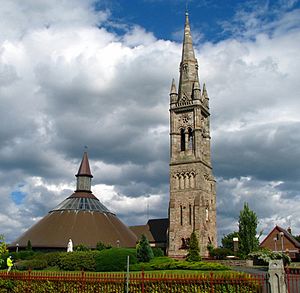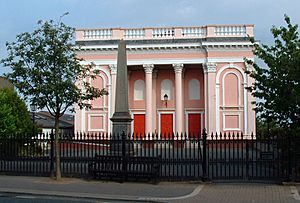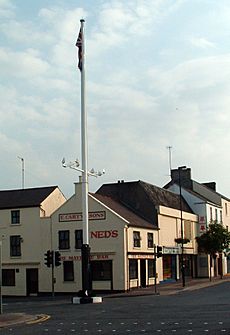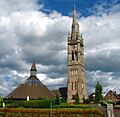Holywood, County Down facts for kids
Quick facts for kids Holywood
|
|
|---|---|
 St Colmcille's church on High Street |
|
| Population | 11,257 (2011 census) |
| District |
|
| County | |
| Country | Northern Ireland |
| Sovereign state | United Kingdom |
| Post town | HOLYWOOD |
| Postcode district | BT18 |
| Dialling code | 028 |
| Police | Northern Ireland |
| Fire | Northern Ireland |
| Ambulance | Northern Ireland |
| EU Parliament | Northern Ireland |
| UK Parliament |
|
| NI Assembly |
|
Holywood is a town in Northern Ireland. It is part of the larger Belfast area. The town is located in County Down. It sits right on the shore of Belfast Lough. This is a large sea inlet between Belfast and Bangor. Holywood is also a "civil parish" and a "townland." These are old ways of dividing up land. The town covers about 755 acres. Places like Holywood Exchange and Belfast City Airport are very close by.
Contents
- What Does the Name Holywood Mean?
- A Brief Look at Holywood's Past
- Who Lives in Holywood?
- Interesting Places to Visit in Holywood
- How to Get Around: Transport in Holywood
- Nature and Wildlife in Holywood
- Industries in Holywood
- Schools in Holywood
- Sports in Holywood
- Famous People from Holywood
- Images for kids
- See also
What Does the Name Holywood Mean?
The name Holywood comes from a Latin phrase, Sanctus Boscus. This means "holy wood." The Normans, who came to Ireland long ago, gave this name to the forests around a special place. This place was a monastery (a home for monks) built by St Laiseran. He founded it before the year 640. Today, the Holywood Priory stands where the monastery once was. The oldest English spelling of the name was Haliwode. This was found in a document from the 1300s.
The Irish name for Holywood is Ard Mhic Nasca. This means "high ground of Mac Nasca."
A Brief Look at Holywood's Past
In the early 1800s, Holywood became a popular place for people to visit. Like many other towns along the coast, it was known for "sea-bathing." This meant people would come to swim in the sea. Many rich business people from Belfast built large homes here. These included families like the Kennedys and the Harrisons. For example, Cultra Manor was built between 1902 and 1904. It is now part of the Ulster Folk and Transport Museums.
A railway line opened in 1848. It connected Belfast to Holywood. This helped the town grow very quickly. In 1900, about 3,500 people lived in Holywood. By 2001, this number had grown to 12,000! Because of all this growth, a new road called the Holywood Bypass was built in 1972.
The Old Priory and Famous People
The ruins of the Old Priory are at the end of High Street. The tower was built around 1800. But some parts of the ruins are much older, from the early 1200s. The Priory has a graveyard where many important people are buried. One was Robert Sullivan, who worked to improve education. Sullivan Upper School is named after him.
Another famous family buried there is the Praeger family. Robert Lloyd Praeger (1865–1953) was a world-famous botanist. A botanist studies plants. His sister, Rosamond Praeger (1867–1954), was a well-known sculptor and writer.
Important Events in Holywood
On 12 April 2010, a car bomb went off near Palace Barracks. This is a British Army base on the edge of Holywood. An older man was knocked over and had to go to the hospital. A group called the Real IRA said they were responsible for the attack.
Who Lives in Holywood?
The 2011 United Kingdom census counted 11,257 people living in Holywood. Here are some facts about them:
- About 18% of the people were under 16 years old.
- About 19% of the people were 65 or older.
- Almost half (49%) were male, and just over half (51%) were female.
- Most people (62%) were from a Protestant or other Christian background.
- About 23% were from a Catholic Christian background.
- Only a small number (3.39%) of people aged 16–74 were unemployed.
Interesting Places to Visit in Holywood
- Holywood is famous for its maypole. This is a tall pole in the middle of town. Its exact beginning is not known. But local stories say it started around 1700. A Dutch ship supposedly got stuck on the shore. The sailors put up their broken mast to thank the townspeople for their help. This was the only original maypole left in Ireland. Sadly, strong winds damaged it in February 2021, and a new one had to be put up.
- The Maypole Bar is a nearby pub. Locals often call it Ned's.
- There is also a Norman "motte" in town. A motte is a small hill that was used for a castle long ago. This one might have been built on an even older burial mound.
- The Ulster Folk and Transport Museum is very close by, in Cultra. This museum shows how people in Ulster used to live. It also has many old vehicles.
How to Get Around: Transport in Holywood
The first part of the Belfast and County Down Railway opened on 2 August 1848. It connected Belfast to Holywood. The Holywood railway station opened at the same time. Later, the railway line was made longer. It went all the way to Bangor. This longer line opened on 1 May 1865. The Holywood station stopped handling goods in 1950.
Nature and Wildlife in Holywood
The waters around Holywood are home to many types of marine algae. These are like plants that grow in the sea. Some examples found here are Polysiphonia elongata and Laurencia obtusa.
Industries in Holywood
The Crosslé Car Company is based in Holywood. This company makes racing cars.
Schools in Holywood
Holywood has several schools for different ages:
- Holywood Primary School
- Holywood Nursery School
- Holywood Rudolf Steiner School
- Priory Integrated College
- Rockport School
- St. Patrick's Primary School
- Sullivan Preparatory School and Sullivan Upper School
Sports in Holywood
Holywood is home to some famous sports stars. These include Formula One driver Eddie Irvine. Christian Lester, a Formula 3 Driver in 2020, also lives here.
Cricket
Holywood Cricket Club started in 1881. It moved to its current location at Seapark Road in 1996.
Football
Holywood F.C. is a football club from Northern Ireland. They play in Division 1B of the Northern Amateur Football League.
GAA (Gaelic Games)
St. Paul's Gaelic Football Club was formed in 1979. It brought together clubs from Holywood, Bangor, and Newtownards.
Golf
Holywood Golf Club was founded in 1904. This is where Rory McIlroy learned to play golf. He is a very famous professional golfer. He won the US Open in 2011, the US PGA in 2012, and The Open and US PGA in 2014. He still calls Holywood Golf Club his home course.
Nearby, in Craigavad, is the Royal Belfast Golf Club. This is the oldest golf club in Ireland. It started in 1881. The course it uses today was designed in 1926.
Famous People from Holywood
Many notable people have connections to Holywood:
- Mark Adair: A former cricketer.
- Desmond Boal: A well-known lawyer and politician.
- Charles Brett: An expert on buildings and history.
- Fr. Stephen Brown: A writer and founder of a library.
- Barbara Callcott: An Australian television personality.
- Darren Cave: Played rugby for Ulster Rugby and Ireland.
- Robert Cunningham: The first Presbyterian minister.
- Jamie Dornan: A famous actor and model.
- Hubert Dunn: A judge and author.
- Garth Ennis: A comic book writer.
- Henry Harrison: A politician buried in the Priory graveyard.
- Maurice Jay: A radio presenter.
- Bap Kennedy: A singer-songwriter.
- Tom Kerr: A comic strip artist.
- Stephen Martin: An international field hockey player.
- Robert McCartney: A lawyer and politician.
- Alban Maginness: A lawyer and politician.
- Rory McIlroy: A world-famous professional golfer.
- Margaret Mountford: A lawyer and businesswoman.
- Dermot Murnaghan: A television news anchor.
- Rachel O'Reilly: A chemist and scientist.
- Rosamond Praeger: An artist, sculptor, and writer.
- Davy Sims: A broadcaster and writer.
- Michael Smiley: A comedian, writer, and actor.
- Clive Standen: An actor.
- John St. Clair Boyd: Born in Holywood.
- Shane Todd: A comedian, writer, and actor.
- Peter Woodman: An archaeologist.
Images for kids
See also
 In Spanish: Holywood para niños
In Spanish: Holywood para niños






